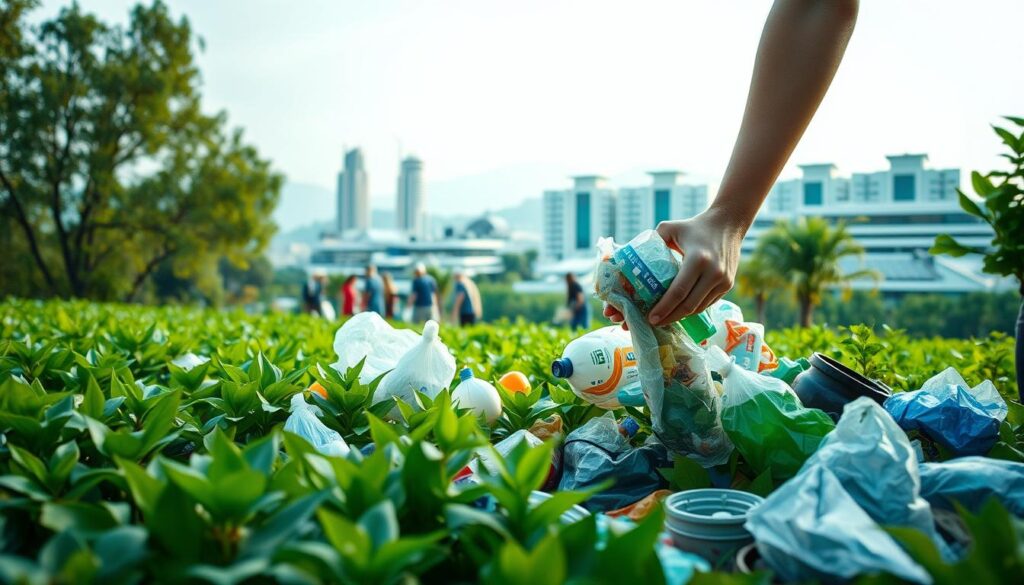Did you know that limiting global warming to 1.5°C requires rapid and unprecedented changes in all aspects of society1? This startling fact highlights the urgent need for action to protect our planet. Every choice we make, from the products we buy to the energy we use, impacts the environment.
Businesses are also stepping up. Companies that adopt greener strategies can reduce operational costs by up to 20% and increase brand loyalty by 25%2. This shift not only benefits the environment but also drives economic growth. For example, reusing products instead of buying new ones can significantly reduce waste and conserve resources.
Individual actions matter too. Simple steps like conserving water, reducing paper use, and choosing energy-efficient options can collectively make a big difference. Together, we can create healthier communities and a brighter future for generations to come.
Key Takeaways
- Global warming requires immediate and widespread changes to limit its impact1.
- Businesses that adopt greener strategies see cost savings and increased loyalty2.
- Reusing products helps reduce waste and conserve resources.
- Conserving water and energy at home contributes to environmental health.
- Every small action adds up to create a significant positive impact.
Introduction to Sustainable Practices
The way we manage resources today shapes the future of our planet. Sustainability is about meeting our needs without compromising the ability of future generations to meet theirs. It’s a balance between environmental health, economic growth, and social equity3.

Why Environmental Action Matters
Every person plays a role in protecting the environment. From conserving water to reducing energy waste, small actions add up. For businesses, adopting greener strategies can lead to cost savings and increased customer loyalty4.
Communities also benefit when they work together. Shared efforts like recycling programs or community gardens can improve quality of life and reduce waste. For example, reducing plastic use can significantly lower pollution levels and protect marine life5.
Key Concepts and Benefits
Understanding climate change is crucial. It’s a global challenge that affects weather patterns, ecosystems, and economies. By embracing renewable energy and reducing carbon footprints, we can mitigate its impact3.
Here are some key benefits of sustainable practices:
- Economic Growth: Businesses that invest in green technologies often see long-term savings and increased competitiveness.
- Healthier Communities: Cleaner air and water lead to better public health outcomes.
- Resource Conservation: Efficient use of resources ensures they last for future generations.
By taking action now, we can create a healthier planet for everyone.
Implementing “sustainable practices” in Daily Life
Measuring your personal impact is the first step toward a greener lifestyle. Every action, from the energy you use to the products you buy, contributes to your carbon footprint. By understanding this, you can make informed choices that benefit the environment.

Understanding Your Impact
Small changes in daily habits can lead to significant environmental benefits. For example, fixing leaks and using water-efficient appliances can save thousands of gallons of water annually6. Similarly, choosing plant-based meals over meat can reduce greenhouse gas emissions by up to 50%7.
Organizations also play a crucial role. Businesses that adopt greener strategies not only reduce emissions but also create green jobs, boosting the economy6. Supporting such companies can amplify your positive impact.
Here are some practical steps to evaluate and reduce your environmental impact:
- Monitor energy use: Switch to energy-efficient appliances and turn off unused devices.
- Reduce waste: Recycle materials and avoid single-use plastics.
- Conserve water: Fix leaks and use water-saving fixtures.
- Choose wisely: Opt for products made from recycled or sustainable materials.
Every step you take adds up. Over time, these small changes can significantly lower your carbon footprint and contribute to a healthier planet. Start today and make a difference for the world of tomorrow.
Practical Steps to Reduce Your Carbon Footprint
Reducing your carbon footprint starts with actionable steps you can take today. From improving energy efficiency at home to choosing low-impact transportation options, small changes can lead to significant environmental benefits. Here’s how you can make a difference.

Energy Efficiency at Home
Improving energy efficiency is one of the most effective ways to lower your carbon footprint. Start by upgrading to energy-saving appliances and LED bulbs, which use up to 90% less energy than traditional options8. Proper insulation and smart thermostats can also reduce energy waste and lower utility bills.
Monitoring your energy use is another key step. Turn off unused devices and unplug electronics when not in use. These small habits can add up to significant savings over time. For example, replacing fluorescent lights with LED bulbs not only cuts energy use but also lasts up to 25 times longer8.
Low-Impact Transportation Options
Transportation is a major contributor to emissions, but there are ways to reduce its impact. Consider carpooling, using public transit, or biking for your daily commute. These choices can significantly lower your carbon footprint while also reducing traffic congestion.
Heavy-duty trucks are the fastest-growing source of emissions, so supporting businesses that prioritize green logistics can make a difference8. Additionally, participating in car-free days or using electric vehicles can further reduce your environmental impact.
By adopting these strategies, you can contribute to a healthier planet while also saving money and resources. Start today and take the first step toward a greener future.
Cutting Down on Plastic and Packaging Waste
Plastic waste is one of the most pressing environmental challenges of our time. An estimated 136 billion milk jugs worth of plastic debris enter the oceans each year, with 80 percent originating from land sources9. This pollution harms marine life, ecosystems, and even human health. Reducing single-use items is essential to combat this crisis.

Transitioning to reusable products is a powerful way to cut down on plastic waste. For example, replacing disposable water bottles with reusable ones can save hundreds of single-use bottles annually. Similarly, using cloth bags instead of plastic ones reduces the demand for harmful packaging10.
Transitioning to Reusable Products
Making the switch to reusable items is easier than you might think. Start with simple changes like carrying a reusable coffee cup or opting for metal straws. These small choices can significantly reduce your plastic footprint over time.
Here are some effective strategies to incorporate reusables into your daily routine:
- Carry reusable bags: Keep them handy for shopping trips to avoid plastic bags.
- Use refillable containers: Opt for glass or stainless steel containers for food storage.
- Choose reusable utensils: Pack a set of bamboo or metal utensils for on-the-go meals.
Smart Shopping Tips
Smart shopping can also minimize packaging waste. Look for products with minimal or recyclable packaging. Supporting businesses that prioritize eco-friendly packaging can drive positive change in the industry10.
Here are some tips to shop smarter:
- Buy in bulk: Purchasing larger quantities reduces packaging waste.
- Choose unwrapped produce: Skip pre-packaged fruits and vegetables.
- Support local businesses: Many local shops offer low-waste options and reusable packaging.
Communities and businesses play a vital role in promoting low-waste choices. By working together, we can create a culture of resourcefulness and environmental responsibility. Every choice you make at the point of purchase can trigger positive change over time.
Adopting Eco-Friendly Home and Garden Solutions
Transforming your home and garden into eco-friendly spaces is easier than you think. By making simple changes, you can conserve resources, support local ecosystems, and reduce your environmental impact. Start with water-wise gardening techniques to create a beautiful and sustainable outdoor space.

Water-Wise Gardening Techniques
Water-wise gardening focuses on conserving water while nurturing native plant species. Native plants require up to 50% less water and fertilizer compared to non-native plants11. This approach not only saves water but also supports local wildlife and reduces maintenance time.
Xeriscaping is another effective method. It reduces the need for irrigation by promoting the use of native plants and minimizing lawn areas12. Smart sprinklers, which detect rainfall and soil moisture, can further reduce water use by up to 30%12.
Eco-Friendly Landscaping Benefits
Eco-friendly landscaping goes beyond water conservation. It reduces energy waste by providing natural shade and insulation. For example, strategically placed trees can lower cooling costs by up to 25%12. Additionally, using organic materials like compost improves soil health and prevents plant disease12.
Here are some key benefits of eco-friendly landscaping:
- Reduced Chemical Use: Organic farming practices increase soil organic matter by 1% to 3% annually11.
- Biodiversity Support: A diverse range of plants can increase beneficial insect populations by up to 50%11.
- Lower Emissions: Vegetable gardens reduce emissions from transport and storage, contributing to a greener lifestyle12.
Step-by-Step Guide to a Sustainable Garden
Creating a sustainable garden is a rewarding project. Start by choosing native plants that thrive in your local climate. Aim for 70% native species to significantly contribute to water conservation efforts12.
Next, incorporate composting into your routine. Composting can reduce household waste by 30% to 50% and improve soil moisture retention11. Use organic matter like grass clippings and leaves to enrich your garden naturally.
Finally, consider using recycled materials for landscaping. This can reduce your carbon footprint by 30% compared to using new materials11. Every step you take contributes to a healthier planet and a more vibrant community.
| Technique | Water Savings | Additional Benefits |
|---|---|---|
| Native Plants | Up to 50% | Supports local wildlife |
| Xeriscaping | Reduces irrigation needs | Minimizes lawn areas |
| Smart Sprinklers | Up to 30% | Detects rainfall and soil moisture |
| Composting | N/A | Improves soil health |
Sustainable Fashion and Conscious Consumer Choices
The fashion industry is undergoing a transformation as consumers and brands unite to address its environmental impact. Fast fashion contributes to 10% of global carbon emissions, exceeding the combined emissions of all international flights and maritime shipping13. This alarming statistic highlights the urgent need for change in the way we produce and consume clothing.

More than 60% of Gen Z consumers prefer to buy from brands that prioritize eco-friendly practices, even if it costs more13. This shift in consumer behavior is driving businesses to adopt greener strategies. For example, H&M’s Conscious Collection uses organic and recycled materials, reflecting a growing trend in the industry13.
Reducing Fast Fashion Impact
Fast fashion’s environmental toll extends beyond carbon emissions. Millions of garments end up in landfills each year, with only a small fraction being recycled14. By choosing secondhand clothing or supporting ethical brands, consumers can significantly reduce waste and promote circular fashion.
Here are some practical steps to make more conscious clothing choices:
- Opt for quality over quantity: Invest in versatile pieces that last longer.
- Support secondhand platforms: Reduce demand for new production by buying pre-loved items.
- Choose eco-friendly materials: Look for organic cotton, Tencel, or recycled polyester.
“The sustainable fashion movement is not just about the environment; it’s about creating a fair and ethical industry for everyone involved.”
Businesses also play a crucial role. Digitalizing the forecasting process can lead to less waste in products, benefiting both B2C and B2B brands15. Additionally, updating transportation methods to eco-friendly options can significantly reduce carbon emissions in logistics15.
By working together, consumers and brands can create a fashion industry that values both the planet and its people. Every conscious choice you make contributes to a healthier environment and a brighter future.
| Strategy | Environmental Benefit | Consumer Impact |
|---|---|---|
| Secondhand Shopping | Reduces textile waste | Saves money |
| Eco-Friendly Materials | Lowers water usage | Supports ethical brands |
| Digital Forecasting | Minimizes overproduction | Reduces costs |
Water Conservation Techniques for a Greener Home
Efficient water use at home can make a significant environmental impact. With water scarcity affecting many regions, adopting conservation methods is essential. These steps not only save resources but also reduce energy costs and support healthier communities.

Upgrading to Low-Flow Fixtures
Installing low-flow fixtures is one of the most effective ways to conserve water. These fixtures can reduce indoor water consumption by 20-60%, depending on the type16. For example, low-flow showerheads and faucets can save hundreds of gallons annually17.
Upgrading to efficient appliances like dishwashers and washing machines also helps. These models use less water and energy, lowering utility bills and reducing emissions16. Every upgrade contributes to a more sustainable home.
Everyday Water-Saving Practices
Small changes in daily habits can lead to big savings. Shortening shower time by just a few minutes can save up to 10 gallons per session17. Fixing leaks promptly is another simple step, as a running toilet can waste up to 200 gallons daily17.
Other tips include using a basin to wash produce instead of running water and turning off the tap while brushing your teeth. These actions add up, making a noticeable difference over time.
Water conservation also supports the green industry by creating jobs in water-efficient technologies16. By adopting these practices, you contribute to a healthier planet and a more resilient community.
Low-Impact Transportation and Green Driving Habits
Transportation choices play a key role in shaping our environmental impact. From daily commutes to long-distance travel, the way we move affects both our planet and our communities. By adopting low-impact alternatives, we can reduce emissions and create healthier environments for everyone.

Transportation accounts for 29% of U.S. greenhouse gas emissions, with light-duty vehicles contributing 58% of that total18. This highlights the urgent need for greener transportation options. Simple changes, like carpooling or biking, can make a significant difference.
Benefits of Car-Free Days
Car-free days are gaining popularity as a way to reduce emissions and promote community well-being. For example, carpooling with four people can save about 72 days’ worth of carbon emissions annually18. These initiatives not only lower pollution but also encourage healthier lifestyles.
Public transportation is another effective solution. It reduces the number of cars on roads, decreasing air pollution and greenhouse gases19. Cities with robust transit systems often see improved air quality and reduced traffic congestion.
Here are some steps to embrace low-impact transportation:
- Bike or walk: Short trips can be made without a car, reducing emissions and improving health.
- Use public transit: Buses and trains are efficient alternatives for longer commutes.
- Carpool: Sharing rides cuts down on fuel use and traffic.
- Drive efficiently: Avoid speeding and use cruise control to save fuel18.
Electric vehicles (EVs) are also a game-changer. They produce zero tailpipe emissions and can save drivers $546 annually in fuel costs18. With federal tax credits of up to $7,500, EVs are becoming more accessible18.
By making smarter transportation choices, we can reduce our carbon footprint and support a healthier planet. Every step counts toward a greener future.
Community Engagement and Local Environmental Action
Local communities hold the power to drive meaningful environmental change. Grassroots efforts, supported by businesses and residents, can lead to significant improvements in resource management and carbon reduction. When people come together, they create a ripple effect that benefits the entire world.
Community-led initiatives often see remarkable success. For example, participatory forest management has increased sustainable resource use by 30% compared to traditional methods20. Similarly, workshops on rainwater harvesting have boosted water availability for agriculture by 50% in water-scarce regions20.

Businesses play a crucial role in supporting these efforts. Companies that collaborate with community groups report a 40% increase in trust and goodwill21. By adopting circular economy models, they can reduce their environmental impact by up to 70%21.
Here are some actionable ways to get involved:
- Join local initiatives: Participate in tree planting or clean-up drives.
- Support ethical businesses: Choose companies that prioritize responsible food production and waste reduction.
- Educate others: Share knowledge about sustainability and its benefits.
Success stories abound. In one case, community-based ecotourism increased local employment by 25%, providing alternative livelihoods20. Another project reduced local waste generation by 20% through collaborative efforts20.
Everyday choices matter. Opting for locally sourced food, reducing material waste, and supporting green businesses can collectively lower your carbon footprint. These small actions contribute to a healthier planet and stronger communities.
| Initiative | Impact | Benefit |
|---|---|---|
| Community Gardens | Increases local food access | Reduces carbon emissions |
| Recycling Programs | Lowers waste generation | Conserves resources |
| Volunteer Clean-Ups | Improves local ecosystems | Enhances community pride |
By working together, communities and businesses can create lasting change. These efforts not only improve local environments but also inspire global action. Start today and be part of the solution.
Promoting Corporate and Organizational Sustainability
Businesses today are redefining their strategies to align with environmental goals, creating a ripple effect across industries. By integrating sustainability into their core operations, companies can achieve measurable benefits while contributing to a healthier planet. This shift is not just about compliance; it’s about creating long-term value for shareholders, employees, and society22.

Integrating Sustainability in Business
Organizations are rethinking their production processes to lower their environmental footprints. For example, many companies are reducing packaging materials and improving fuel efficiency, leading to significant cost savings22. These changes not only benefit the environment but also enhance operational efficiency and brand reputation23.
More than half of consumers today intentionally choose to interact with organizations that prioritize sustainability23. This trend is driving businesses to adopt greener strategies, such as setting SMART goals for sustainability—Specific, Measurable, Achievable, Relevant, and Time-bound23.
Here are some strategic steps companies can take to shift towards more environmentally friendly practices:
- Conduct sustainability audits: Evaluate key metrics like carbon footprint, water usage, and energy expenditures23.
- Invest in renewable energy: Transitioning to solar or wind power can reduce emissions and energy costs22.
- Adopt circular economy models: Reusing materials and reducing waste can lower environmental impact by up to 70%23.
Companies that successfully integrate sustainability into their corporate culture often see enhanced employee motivation and satisfaction24. This cultural transformation requires endorsement from leadership and adequate resources to drive initiatives effectively24.
| Strategy | Benefit | Example |
|---|---|---|
| Renewable Energy | Reduces emissions | Solar panel installations |
| Circular Economy | Lowers waste | Recycling programs |
| SMART Goals | Improves accountability | Carbon reduction targets |
By adopting these strategies, businesses can create long-term value while contributing to a healthier environment. Every step towards sustainability is a step towards a brighter future.
Understanding Environmental Sustainability: Facts and Figures
Environmental sustainability is a global priority, supported by data-driven insights and actionable strategies. The world faces significant challenges, from climate change to resource depletion, but businesses and communities are stepping up to address these issues. Let’s explore the facts and figures that highlight the current state of sustainability and the steps being taken to create a greener future.

Data-Driven Insights from Global Initiatives
In 2023, the top three greenhouse gas emitters—China, the U.S., and India—contributed 42.6% of total emissions, while the bottom 100 countries accounted for only 2.9%25. This disparity underscores the need for global cooperation in reducing emissions. The global average temperature in 2023 was 1.45°C above pre-industrial levels, emphasizing the urgency of action25.
To limit warming to 1.5°C, global emissions must be reduced by 43% by 203025. This ambitious goal requires significant changes in how we produce and consume resources. For example, food production contributes to 25-30% of greenhouse gas emissions, highlighting the need for more efficient agricultural practices25.
Businesses are also playing a crucial role. Companies that invest in renewable energy and circular economy models can reduce their environmental impact by up to 70%26. These strategies not only benefit the planet but also drive economic growth and innovation.
The Role of Business and Innovation
More than half of consumers today prefer to buy from companies that prioritize sustainability, even if it costs more26. This shift in consumer behavior is driving businesses to adopt greener strategies. For example, products with ESG-related claims accounted for 56% of all growth over the last five years25.
Gen Z and Millennial customers are 27% more likely to purchase from sustainable brands compared to older generations25. This trend is encouraging companies to innovate and create products that meet the demands of eco-conscious consumers.
Here are some key trends in sustainable business practices:
- Renewable Energy: Transitioning to solar or wind power reduces emissions and energy costs25.
- Circular Economy: Reusing materials and reducing waste lowers environmental impact26.
- SMART Goals: Setting specific, measurable goals improves accountability and results26.
Reducing Waste and Plastic Consumption
Plastic waste remains a significant challenge, with 80% of global plastic waste potentially recyclable by 204025. Communities and businesses are working together to reduce plastic use and promote recycling. For example, 62 million metric tons of e-waste were generated globally in 2022, with a 32% increase expected by 203025.
Consumers are also taking action. 46% of consumers are purchasing more sustainable products to reduce their carbon footprint25. This shift in behavior is driving demand for eco-friendly alternatives and encouraging companies to innovate.
| Initiative | Impact | Benefit |
|---|---|---|
| Renewable Energy | Reduces emissions | Lowers energy costs |
| Circular Economy | Reduces waste | Conserves resources |
| SMART Goals | Improves accountability | Drives better results |
By analyzing these figures, we can better understand the critical role of sustainability in today’s economy and environment. Every choice we make, from the products we buy to the resources we use, contributes to a healthier planet. Start today and be part of the solution.
Conclusion
Every small step we take today shapes a healthier tomorrow. From reducing plastic waste to adopting green transportation, every action contributes to a better environment. Businesses and communities play a vital role in driving this change. For example, companies that prioritize energy efficiency can reduce costs by 30% while lowering their carbon footprint27.
Individuals also have the power to make a difference. Simple choices, like conserving resources or supporting eco-friendly brands, can collectively create a significant impact. Research shows that 70% of consumers are willing to pay more for products from companies committed to positive change28.
Together, we can build a brighter future. Start today by implementing the steps outlined in this guide. Every decision, whether it’s reducing waste or choosing sustainable options, matters. Join the movement and be part of the solution for a healthier planet.
FAQ
Why is environmental action important for the community?
How can I reduce my carbon footprint at home?
What are some low-impact transportation options?
How can I cut down on plastic and packaging waste?
What are water-wise gardening techniques?
How can I make sustainable fashion choices?
What are the benefits of upgrading to low-flow fixtures?
How can businesses integrate sustainable practices?
What role does community engagement play in environmental action?
Where can I find data-driven insights on global sustainability efforts?
Source Links
- Embracing Sustainable Development: A Path to a Better Future – https://medium.com/@anandv_62921/embracing-sustainable-development-a-path-to-a-better-future-3084e0ea3b98
- Embracing the Future: Sustainable Business Practices for a Better Tomorrow – https://www.linkedin.com/pulse/embracing-future-sustainable-business-practices-better-wei-hong-tan-vsosc
- What Is Sustainability? (And Why Is It Important?) – https://www.coursera.org/articles/what-is-sustainability
- What is Environmental Sustainability? Goals With Examples – https://www.snhu.edu/about-us/newsroom/stem/what-is-environmental-sustainability
- PDF – https://policy.ucop.edu/doc/3100155/sustainablepractices
- Sustainable practices examples for a healthier planet – https://www.worldpackers.com/articles/sustainable-practices-examples
- How to achieve environmental sustainability – https://greenly.earth/en-us/blog/company-guide/how-to-achieve-environmental-sustainability
- Implementing Sustainable Practices In Business – https://www.forbes.com/councils/forbesbusinesscouncil/2024/05/28/implementing-sustainable-practices-in-business/
- 10 Ways to Reduce Plastic Pollution – https://www.nrdc.org/stories/10-ways-reduce-plastic-pollution
- Why reduction is the key to truly sustainable packaging materials – https://smartsolve.com/news/recycling-alone-isnt-enough-why-reduction-is-the-key-to-meeting-sustainable-packaging-goals/
- Sustainable Gardening | 10 Eco-friendly Tips – https://www.vioscapes.com/blogs/news/10-eco-friendly-tips-for-sustainable-gardening
- How to Create a Sustainable Home Garden: 2025 Guide – https://www.lorddecor.com/blog/how-to-create-a-sustainable-home-garden-s
- Sustainable Fashion: Conscious Consumerism Is Here – https://council.rollingstone.com/blog/sustainable-fashion-and-conscious-consumerism
- Why Sustainable Fashion Matters (And How to Make Better Choices) – Fashion Post Magazine – https://www.lefashionpost.com/2025/02/26/why-sustainable-fashion-matters-and-how-to-make-better-choices-2/
- The Importance Of Sustainability In Fashion – https://www.forbes.com/councils/forbestechcouncil/2024/04/26/the-importance-of-sustainability-in-fashion/
- Warhome | Water Conservation Techniques in Eco-Friendly Home Design – https://www.warehome.co.uk/articles/water-conservation-techniques-in-eco-friendly-home-design
- Water-Saving Practices and the Role of Water Filtration Systems – https://weswater.com/2024/12/water-conservation-tips-for-a-sustainable-home-water-saving-practices-and-the-role-of-water-filtration-systems/
- Eco-friendly Driving and Other Sustainable Lifestyle Tips | Bankrate – https://www.bankrate.com/insurance/car/eco-friendly-driving/
- Analyzing Global Trends in Sustainable Transport – https://www.jusdaglobal.com/en/article/global-trends-sustainable-transport-analysis/
- Community Involvement in Environmental Protection as a Key to Successful Environmental Projects – One More Tree Foundation – https://one-more-tree.org/blog/2024/04/05/community-involvement-in-environmental-protection-as-a-key-to-successful-environmental-projects/
- How to Develop Sustainable Community Engagement Strategies – https://blog.veolianorthamerica.com/how-to-develop-sustainable-community-engagement-strategies
- The 3 Pillars of Corporate Sustainability – https://www.investopedia.com/articles/investing/100515/three-pillars-corporate-sustainability.asp
- Exploring Sustainability in Business: Best Practices | JWU CPS – https://online.jwu.edu/blog/sustainable-business-practices-exploring-sustainability-in-business/
- From paper to practice: Creating a corporate culture rooted in sustainability – CORE – https://peopleatcore.com/from-paper-to-practice-creating-a-sustainability-culture/
- 50+ essential sustainability statistics to know in 2024 – https://greenplaces.com/articles/50-essential-sustainability-statistics-for-2024/
- Sustainability – https://www.eea.europa.eu/en/topics/at-a-glance/sustainability
- Implementing Sustainable Practices: A Step-by-Step Guide for Businesses — GivingForce – https://www.givingforce.com/blog/implementing-sustainable-practices
- Sustainable Practices and Organizational Performance – https://psico-smart.com/en/blogs/blog-sustainable-practices-and-organizational-performance-12032
